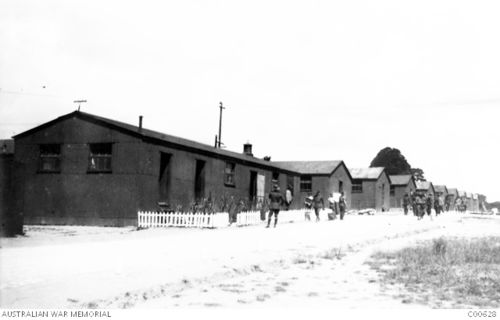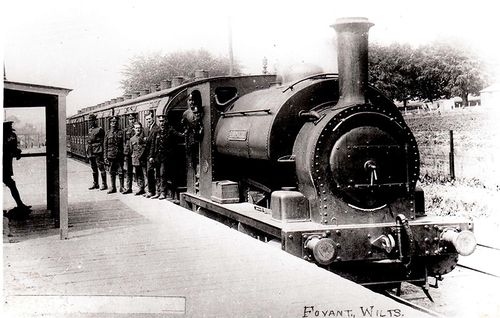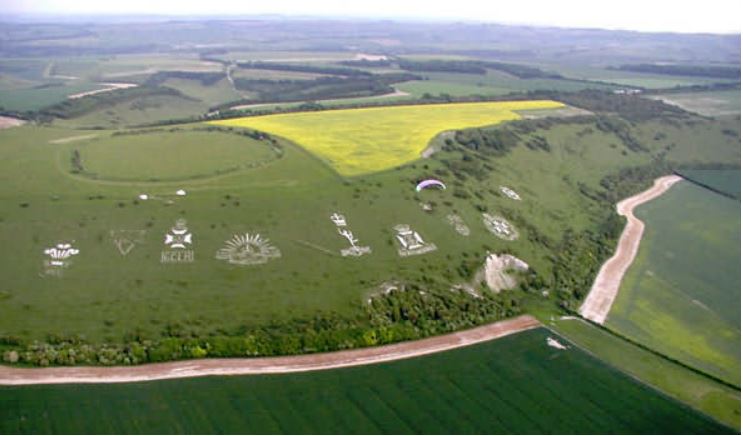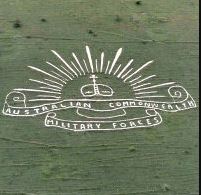Difference between revisions of "Fovant"
From Our Contribution
(→Soldiers who passed this way!) |
|||
| (44 intermediate revisions by the same user not shown) | |||
| Line 5: | Line 5: | ||
| subheader = | | subheader = | ||
| − | | image = [[File:Fovant_camps.jpg]] | + | | image = [[File:Fovant_camps.jpg|border|500px]] |
| − | | caption = Each of the numbered boxes represents a group of | + | | caption = Each of the numbered boxes represents a group of 30 or more huts |
| − | | image2 = [[File:Fovant_1918.jpg]] | + | | image2 = [[File:Fovant_1918.jpg|border|500px]] |
| − | | caption2 = | + | | caption2 = Camps 1-4 on left with chalk badges in background |
| − | | image3 = [[File: | + | | image3 = [[File:Sutton_Mandeville_camp.jpg|600px]] |
| − | + | | caption 3 = Map showing Fovant camp and surrounds | |
| − | | | ||
| − | | | ||
|headerstyle = background:#ccf; | |headerstyle = background:#ccf; | ||
|labelstyle = | |labelstyle = | ||
|datastyle = | |datastyle = | ||
| − | |||
| − | |||
| − | |||
| − | |||
| − | |||
| − | |||
| − | |||
| − | |||
| − | |||
| − | |||
| − | |||
| − | |||
| − | |||
| − | |||
| − | |||
| − | |||
| − | |||
| − | |||
| belowstyle = | | belowstyle = | ||
| Line 41: | Line 21: | ||
| − | ==Remarks==Fovant is a village in south west Wiltshire, England about 14 km west of Salisbury. The village existed prior to the drawing up of the Domesday Book in 1086. | + | ==Remarks== |
| + | Fovant is a village in south west Wiltshire, England about 14 km west of Salisbury. The village existed prior to the drawing up of the Domesday Book in 1086. | ||
| − | During WW1 temporary camps were built to handle training and medical treatment of soldiers. Fovant housed 20,000 men in prefab wooden huts with corrugated iron cladding and roofs, wood burning stove in the centre and about 30 men per hut. | + | During WW1 temporary camps were built to handle training and medical treatment of soldiers. Fovant housed 20,000 men in prefab wooden huts with corrugated iron cladding and roofs, wood burning stove in the centre and about 30 men per hut. The main part of the camp was on East Farm stretching from the downs north to Fovant Woods, a mile in distance and half a mile wide. This comprised five groups of accommodation and recreational huts (cinema, YMCA, Post Office) Officers’ accommodation and HQ Offices as well as parade ground and training facilities. |
| − | As the building materials arrived at Dinton Station and required hauling the 5 miles to Fovant it soon became clear that a spur railway line would be essential. The Fovant Military Railway conncted the camps with the main rail system at Dinton. | + | As the building materials arrived at Dinton Station and required hauling the 5 miles to Fovant it soon became clear that a spur railway line would be essential. The Fovant Military Railway conncted the camps with the main rail system at Dinton. This was used for moving stores, equipment, wounded personnel and occasionally villagers. The soldiers marched. |
| − | This was used for moving stores, equipment, wounded personnel and occasionally villagers. | ||
At least one Brigade, arriving in the small hours one cold December night, sang to cheer themselves up as they marched to camp. Not so popular with tired villagers! | At least one Brigade, arriving in the small hours one cold December night, sang to cheer themselves up as they marched to camp. Not so popular with tired villagers! | ||
| Line 52: | Line 32: | ||
It is also the site of the badges cut into the chalk of a nearby hill, including the Australian hat badge. | It is also the site of the badges cut into the chalk of a nearby hill, including the Australian hat badge. | ||
| − | AIF battalions were housed at Fovant while engaged in training activities on the Salisbury Plain. There was a 600 bed hutted military hospital at Fovant during the First World War, and the concentration of Australian depots and training camps in the area is reflected in that there are 63 First World War burials in the local church's graveyard. | + | AIF battalions were housed at Fovant while engaged in training activities on the Salisbury Plain. There was a 600 bed hutted military hospital at Fovant during the First World War, and the concentration of Australian depots and training camps in the area is reflected in that there are 63 First World War burials in the local church's graveyard. In March 1917 the Australian Command Depot No.3 moved here from Hurdcott along with a Convalescent camp. From October 1917 the 2nd Division's Training Battalions, i.e. the 5th, 6th, and 7th Training Battalions were based here. Hurdcott camp, one of the larger Australian ones in England was 8-9 kms to the east at Compton Chamberlayne. See separate page. |
| + | |||
| + | When the fighting finished Fovant was one of three camps in England's South West designated as demobilisation centres for returning soldiers. | ||
| + | |||
| + | Australian soldiers stayed in Hurdcott for many months. Lacking the motivation of training and the structure of army discipline, boredom quickly became a problem. Unlike the fatal rioting on the Plain there was a little “rowdyism” at Hurdcott. One farmer tells of being stopped by a barricade at the camp entrance and made to drink a pint of beer with the ‘guard’ before being allowed to continue to his home at Fovant. | ||
| + | |||
| + | ==Soldiers who passed this way!== | ||
| − | + | ''1916'' | |
| − | |||
| − | + | ''1917'' | |
| + | * [Leslie Jeffery Harvey]] 17 Feb - 10 Jul 1917 - Pioneer Training Battalion | ||
| + | * [[Henry Ogilvie Allom (Jnr)]] 28 Mar - 17 Apr 1917 - Fovant Hospital | ||
| + | * † [[Robert Melville Salter]] 28 Mar - 22 Oct 1917 - 11th training battalion | ||
| + | * [[James Arthur (Artie) Williams]] 13 Oct - 3 Nov 1917- Fovant Hospital | ||
| − | |||
| + | ''1918'' | ||
| + | * † [[David Alexander Sayer]] 5 & 6 Feb 1918 - Fovant Military Hospital | ||
| + | * [[William Plant]] 24 - 28 Feb 1918 - Fovant Military Hospital | ||
| + | * [[George Emanuel Harber]] 5 Apr - 3 Jun 1918 - 5th Training Battalion | ||
| + | * [[Jason Howard]] 3 Jun 1918 - 30 May 1919 - 9th Training Battalion | ||
| + | * [[Harry Douglas Butcher]] 21 Apr - 9 Jul 1918 -14th Training Battalion | ||
| + | * [[John Paterson Henderson]] 13 Aug - 9 Sep 1918 - AAMC Training Depot | ||
| + | * [[Oliver John Dowell]] 17 Aug - 3 Oct 1918 - 5th Training Battalion | ||
| + | |||
| + | <div><ul> | ||
| + | <li style="display: inline-block;"> [[File:Fovant_huts.jpg|thumb|none|500px|One of the camps]] </li> | ||
| + | <li style="display: inline-block;"> [[File:Fovant_railway_station.jpg|thumb|none|500px|Railway station that served the camps]] </li> | ||
| + | <li style="display: inline-block;"> [[File:Fovant_badges.jpg|thumb|none|800px|The Fovant Badges on the Chalk Downs of Wiltshire]] </li> | ||
| + | <li style="display: inline-block;"> [[File:Fovant_badge.jpg|thumb|none|500px|Australian Hat Badge Design]] </li> | ||
| + | </ul></div> | ||
==Notes== | ==Notes== | ||
| + | |||
<references /> | <references /> | ||
==External Links== | ==External Links== | ||
| − | {{DEFAULTSORT: | + | {{DEFAULTSORT:Fovant , given names}} |
[[Category:Camps]] | [[Category:Camps]] | ||
Latest revision as of 16:57, 30 September 2021
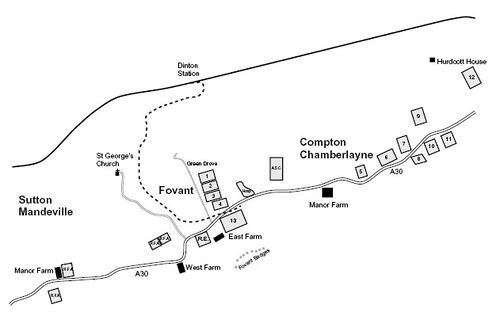 Each of the numbered boxes represents a group of 30 or more huts | |
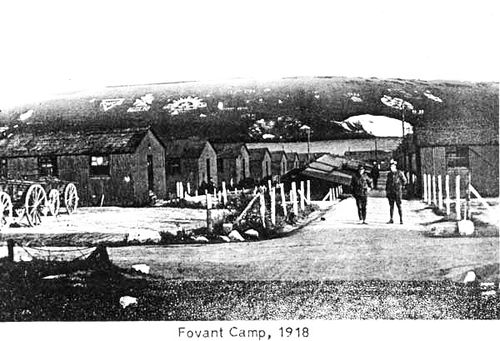 Camps 1-4 on left with chalk badges in background | |
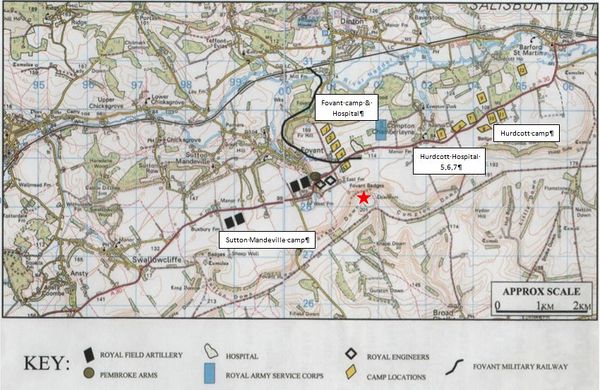 |
Remarks
Fovant is a village in south west Wiltshire, England about 14 km west of Salisbury. The village existed prior to the drawing up of the Domesday Book in 1086.
During WW1 temporary camps were built to handle training and medical treatment of soldiers. Fovant housed 20,000 men in prefab wooden huts with corrugated iron cladding and roofs, wood burning stove in the centre and about 30 men per hut. The main part of the camp was on East Farm stretching from the downs north to Fovant Woods, a mile in distance and half a mile wide. This comprised five groups of accommodation and recreational huts (cinema, YMCA, Post Office) Officers’ accommodation and HQ Offices as well as parade ground and training facilities.
As the building materials arrived at Dinton Station and required hauling the 5 miles to Fovant it soon became clear that a spur railway line would be essential. The Fovant Military Railway conncted the camps with the main rail system at Dinton. This was used for moving stores, equipment, wounded personnel and occasionally villagers. The soldiers marched.
At least one Brigade, arriving in the small hours one cold December night, sang to cheer themselves up as they marched to camp. Not so popular with tired villagers!
It is also the site of the badges cut into the chalk of a nearby hill, including the Australian hat badge.
AIF battalions were housed at Fovant while engaged in training activities on the Salisbury Plain. There was a 600 bed hutted military hospital at Fovant during the First World War, and the concentration of Australian depots and training camps in the area is reflected in that there are 63 First World War burials in the local church's graveyard. In March 1917 the Australian Command Depot No.3 moved here from Hurdcott along with a Convalescent camp. From October 1917 the 2nd Division's Training Battalions, i.e. the 5th, 6th, and 7th Training Battalions were based here. Hurdcott camp, one of the larger Australian ones in England was 8-9 kms to the east at Compton Chamberlayne. See separate page.
When the fighting finished Fovant was one of three camps in England's South West designated as demobilisation centres for returning soldiers.
Australian soldiers stayed in Hurdcott for many months. Lacking the motivation of training and the structure of army discipline, boredom quickly became a problem. Unlike the fatal rioting on the Plain there was a little “rowdyism” at Hurdcott. One farmer tells of being stopped by a barricade at the camp entrance and made to drink a pint of beer with the ‘guard’ before being allowed to continue to his home at Fovant.
Soldiers who passed this way!
1916
1917
- [Leslie Jeffery Harvey]] 17 Feb - 10 Jul 1917 - Pioneer Training Battalion
- Henry Ogilvie Allom (Jnr) 28 Mar - 17 Apr 1917 - Fovant Hospital
- † Robert Melville Salter 28 Mar - 22 Oct 1917 - 11th training battalion
- James Arthur (Artie) Williams 13 Oct - 3 Nov 1917- Fovant Hospital
1918
- † David Alexander Sayer 5 & 6 Feb 1918 - Fovant Military Hospital
- William Plant 24 - 28 Feb 1918 - Fovant Military Hospital
- George Emanuel Harber 5 Apr - 3 Jun 1918 - 5th Training Battalion
- Jason Howard 3 Jun 1918 - 30 May 1919 - 9th Training Battalion
- Harry Douglas Butcher 21 Apr - 9 Jul 1918 -14th Training Battalion
- John Paterson Henderson 13 Aug - 9 Sep 1918 - AAMC Training Depot
- Oliver John Dowell 17 Aug - 3 Oct 1918 - 5th Training Battalion
Notes
